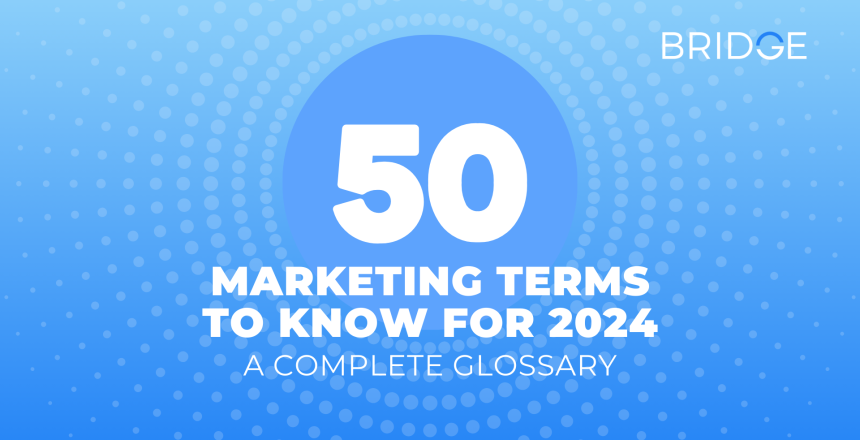As the digital marketing industry evolves, staying updated with the latest trends, skills, and terminology is key to success. This comprehensive guide outlines 50 essential marketing terms you should familiarize yourself with. Whether you’re a seasoned marketer or a budding professional, this glossary is a valuable resource.
The Basics
Understanding the basics of digital marketing is the foundation upon which all other knowledge is built. This section covers fundamental concepts and terminology that form the backbone of digital marketing.
- Audience Behavior: Audience behaviors transcend race, age, and location and are more likely to connect you to a wider range of people who will use your product effectively. Information that can be used to target audience behaviors includes the total number of times they visit a website, the types of pages that they’re likely to visit, and the types of terms that they enter into internet search engines. This information can shed light on the way a person thinks, which allows you to target your product in new and effective ways.
- B2B (Business-To-Business): Businesses whose primary customers are other businesses.
- B2C (Business-To-Consumer): Businesses whose primary customers are consumers.
- Brand Awareness: Research studies can associate ad effectiveness to measure the impact of online advertising on key branding metrics.
- Brand Image: A company’s brand image encompasses everything about how a company portrays itself to the public, including its customers, employees, and stakeholders. When consumers think of a brand, what else comes to mind? What is synonymous with that brand to consumers? Influential elements can include a logo, color palette, products, messaging, tone, philanthropy, industry, goals, collateral, etc.
- Affiliate Marketing: An agreement between two sites in which one site (the affiliate) agrees to feature content or an ad designed to drive traffic to another site. In return, the affiliate receives a percentage of sales or some other form of compensation generated by that traffic.
- Lead Generation: The action or process of identifying and cultivating potential customers for a business’s products or services.
- Omni-Channel: Omni-Channel refers to the marketing approach that integrates the user experience across platforms from beginning to end. The platforms that are used include mobile devices, email, brick-and-mortar, telephone, and more.
- Opt-In: Refers to an individual giving a company permission to use data collected from or about the individual for a particular reason, such as to market the company’s products and services. See permission marketing.
- Opt-Out: When a company states that it plans to market its products and services to an individual unless the individual asks to be removed from the company’s mailing list.
- Pay Per Click (PPC): An advertising pricing model in which advertisers pay agencies and/or media companies based on how many users click on an online ad or e-mail message through to their website. The amount paid per click-through is arranged at the time of the insertion order and varies considerably.
- People-Based Marketing: People-based marketing connects people’s digital selves (their mobile IDs, desktop cookies, Connected TV data, etc.) with their real-world selves (PII data that’s ethically sourced). All of which is to say that you know them as people and value them as such.
- Programmatic: Media or ad buying that uses technology to automate and optimize, in real-time, the ad buying process. This ultimately serves targeted and relevant experiences to consumers across channels. On the back end, algorithms filter ad impressions derived from consumer behavioral data, which allows advertisers to define budget, goal, and attribution and optimize for reduced risk while increasing ROI.
- Customer Experience: The customer experience is comprised of a customer’s entire interaction with an organization throughout their relationship. The experience includes product or service interest, discovery, purchase, and use. Businesses strive to meet and exceed customers’ expectations by providing the ultimate customer experience.
Key Performance Metrics (KPIs) and Reporting
Due to the broad range of channels and strategies in digital marketing, it is necessary to have the right metrics and comprehensive reporting in order to determine the effectiveness of a campaign, understand consumer behavior, and make data-driven decisions.
- Click-Through Rate (CTR): The percentage of ad impressions that were clicked on as compared to the entire number of clicks [CTR% = (clicks ÷ imps) x 100], the ratio of users who click on a specific link to the number of total users who view a page, email, or advertisement. CTR is commonly used to measure the success of an online advertising campaign for a particular website as well as the effectiveness of email campaigns.
- Conversion Rate: The percentage of users who complete the desired action (e.g., purchase or registration) compared to all users who were exposed to an online ad.
- Cost Per Lead (CPL): A more specific form of cost per action in which a visitor provides enough information at the advertiser’s site (or in an interaction with a rich media ad) to be used as a sales lead. You can estimate the cost per lead regardless of how you pay for the ad (in other words, buying on a pay-per-lead basis is not required to calculate the cost per lead).
- Call To Action (CTA): A CTA is a clickable graphic, image, or button that is created to entice a viewer to respond to whatever is being asked. For example, a CTA could ask for a person’s name and email address in exchange for more information on a certain topic.
- Engagement Rate: Number of engagements/impressions (as a percentage).
- Foot Traffic Attribution (FTA): Foot traffic attribution is an attribution tool that analyzes your target audience and ties them to your in-store visits to provide accurate, measurable results of your advertising efforts.
- Key Performance Indicators (KPIs): A business metric used to evaluate factors that are crucial to the success of an organization. KPIs differ based on the business and marketing focus. For example, KPIs could be net revenue or a customer loyalty metric. Also known as key success indicators (KSI).
- Point-of-Sale (POS) Matchback: A process implemented to determine who did or did not respond from each specific channel. This multi-channel attribution is performed after a campaign has been employed to give us a clear understanding of which channel was the strongest contributor to the sale.
- ROI (Return on Investment): Net profit divided by investment.
Data
People-based data has transformed the landscape of digital marketing, allowing marketers to create more personalized, targeted, and efficient campaigns. By understanding a consumer’s digital footprints and linking these with real-world identities, marketers can deliver tailored messaging that resonates on a personal level.
- Data Aggregator: A data aggregator is an organization that collects and compiles data from various sources, often offering results or access for resale. There are three primary types of data aggregators: online, offline, and personal.
- Data Append: User data from one source is linked to a user’s profile from another source.
- Data Hygiene: Data hygiene is the process of identifying and correcting potentially dangerous or harmful records within a file or database. Data hygiene metrics can include complaint ratios, unsubscribe rates, trap listings, compliance postings, trend analysis, etc.
- Data Management Platform (DMP): A system that allows the collection of audience intelligence by advertisers and ad agencies, thereby allowing better ad targeting in subsequent campaigns on a combination of in-depth first- and third-party audience data. They help to accurately target campaigns to these audiences across third-party ad networks and exchanges, and measure with accuracy how campaigns perform.
- Data Onboarding: Data onboarding, also known as “data on-ramping,” facilitates the transfer of data gathered offline to an online database. It is used to connect offline customer records with online users through matching technology. Data onboarding enables an individual to leverage accurate customer data as a result of their marketing campaign. By identifying information from offline datasets we can gather those same customers online.
- Data Profiling: Data profiling is the process of statistically analyzing existing data to gain complete insight into the quality of the data in your systems. The analysis determines data structure and identifies internal relationships. Data profiling measures for a variety of variables including completeness of a data set, uniqueness of values, distribution of records, and more. It should be used to improve data quality.
Display and Search Advertising
The digital marketing landscape is continually evolving, and two of its most critical components are Display and Search Advertising. These strategies enable businesses to reach their targeted audiences more efficiently and effectively.
- Banner Ad: A banner ad is a rectangular image-based internet advertisement. Banner ads that appear at the top or bottom of a web page are called leaderboards and banner ads on the sides of a web page are called skyscrapers.
- Display Advertising: A form of online advertising where an advertiser’s message is shown on a destination web page, generally set off in a box at the top or bottom or to one side of the content of the page.
- Interstitial: Between-the-page ad units displayed as a user navigates from one web page to the next web page. The ad appears after the user leaves the initial page but before the target page displays on the user’s screen. Typically, the ad is self-contained within its own browser window, but may also appear briefly as an overlay on the target page rather than in its own browser window. Also known as transition ads, intermercial ads, and splash pages, also known as ‘between-the-page.’
- Native Advertising: A form of paid media where the ad experience follows the natural form and function of the user experience in which it is placed. These paid ads aspire to be so cohesive with the page content, assimilated into the design, and consistent with the platform behavior that the viewer simply feels that they belong.
- Search Targeting: Local search targeting helps advertisers target users when they look for places, businesses, housing, entertainment, etc. In specific geographies using a search engine (such as Google or Bing). This allows advertisers to present highly relevant localized offers and advertisements to users.
- SEO (Search Engine Optimization): The process of improving the volume and quality of traffic to a website from search engines via natural (organic or algorithmic) search results.
Email Advertising
Email advertising is a powerful and vibrant form of digital marketing. It offers marketers the chance to reach a vast audience at a relatively low cost, reinforcing brand recognition, and promoting products or services directly to individuals who have expressed interest in a brand.
- Bounce Rate: Figured as a percentage, this compares the number of visitors to a website who arrive and immediately leave vs. Those who stay and spend time on the site; can be used to measure the effectiveness of a website, a search campaign, or an ad campaign.
- Email Advertising: Banner ads, links, or advertiser sponsorships that appear in email newsletters, email marketing campaigns, and other commercial email communications. Includes all types of electronic mail (e.g., basic text or HTML-enabled).
- Hard Bounce: When an email cannot be delivered to a subscriber’s inbox for any type of permanent reason, it is classified as a hard bounce. Some permanent reasons can include: sending to an invalid email address, sending to an invalid domain, or subscriber’s server blocking delivery. Addresses with hard bounces should be immediately removed from email lists.
- Soft Bounce: When an email cannot be delivered to a subscriber’s inbox for any type of temporary reason, it is classified as a soft bounce. Some temporary reasons include: the subscriber’s email inbox is full, the subscriber’s email server is down, or the email is too large. Temporary reasons can be resolved and email addresses can stay on the company’s email list.
Video and Audio Advertising
In the realm of digital marketing, Video and Audio Advertising holds a prominent position. As media consumption habits evolve, advertisers are increasingly leveraging video and audio channels to capture audience attention and deliver their messages more effectively.
- Connected TV (CTV): A television set that is connected to the internet and is able to access web-based content also referred to as advanced TV. TVs can be connected through an add-on device like PlayStation, Roku, or an Amazon Fire tv stick. The content viewed is all video-on-demand, and streams similarly to how you would stream video content on your computer, smartphone, or tablet. Ott (over the top) is a term used to describe any of the devices used to connect a TV to the internet.
- Cross-Screen Measurement: The tracking and measurement of video metrics across mobile/tablet/out-of-home/television/advanced TV/desktop that can be tied to the same user.
- Linear Video Ads: Experienced in-stream, which is presented before, between, or after the video content is consumed by the user. One of the key characteristics of linear video ads is the ad takes over the full view of the video.
- Pre-Roll: A pre-roll video ad is an in-stream video ad that occurs before the video content the user has requested. See also post-roll and mid-roll.
- Mid-Roll: A linear video spot appears in the middle of the video content. See pre-roll and post-roll.
- Post-Roll: A linear video spot appears after the video content is completed. See pre-roll and midr-oll.
- Video Ad Completion Rate (VCR): The percentage of all video ads that play through their entire duration to completion. Also known as view-through rate (VTR) and video completion rate (VCR). Not to be confused with the videocassette recorder.
Social Media Advertising
Social media advertising leverages various social networking platforms to reach target audiences with strategic messaging. It includes methods such as sponsored content, targeted ads, and influencer partnerships. These techniques are used to increase visibility, generate leads, and boost conversions.
- Content Marketing: Content marketing is any marketing that involves the creation and sharing of media and publishing content to acquire and retain customers.
- Self-Serve Media: Self-serve advertising is often associated with text advertising, paid search campaigns, and social platforms like Facebook and Twitter. These terms are not synonymous, but they do share a common goal of efficiency: eliminating the expense of an advertising salesperson. The self-serve model allows publishers to offer smaller minimum ad buys that would otherwise not be profitable. Self-serve programs make advertising easier for small businesses that do not have compelling graphical ads, preventing delays in the do-it-yourself campaign signup.
- Social Marketing: A marketing tactic that taps into the growth of social networks, encouraging users to adopt and pass along widgets or other content modules created by a brand, or to add a brand to the user’s social circle of friends.
- User-Generated Content (UGC): Web content (either written or recorded as a photo, audio, or video) by people who are not professional content creators; so, for example, reader comments; amateur/home videos/audio/photos.
Leveraging your business’ online presence this year by understanding and utilizing these digital marketing terms will augment your brand visibility and audience engagement. Each of these terms contributes to the success of your digital marketing strategy in its own unique way.
As we continue into 2024, staying abreast of these key terms will help you effectively manage the digital landscape, ensuring your business remains ahead of the curve.







